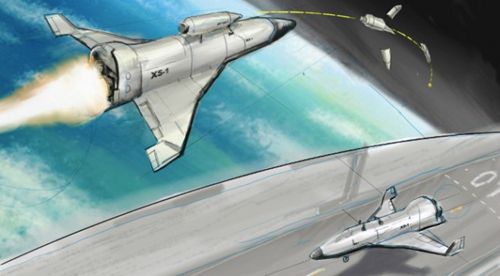MeraForum Community.No 1 Pakistani Forum Community

| Space & Aviation Share space & aviation stuffs here |
| Advertisement |
|
|
Thread Tools | Display Modes |
|
|
|
(#1)

|
|
||||
 Show Printable Version Show Printable Version
 Email this Page
09-30-2013, 01:31 AM Email this Page
09-30-2013, 01:31 AM
 DARPA is now beginning to narrow in on a design for the XS-1, an experimental spaceplane that would allow quick, relatively inexpensive access to orbital altitudes. DARPA foresees a “one day turnaround,” or daily launches for the unmanned orbital delivery drone — and why not? With no pilot and small financial footprint, why not make daily updates to your orbital assets? Space is now too expensive even for the US government. Despite a few major innovations, like the space shuttle, it’s always cost a lot to go to space, or to put your belongings there. This fact has slowed the development of orbital technology, but now that development seems to have reached a tipping point. Today it seems that the potential of space is so great — and so near — that it’s finally becoming necessary to invest in the fundamentals. If we want to keep advancing we’ll need to make better use of the area surrounding our planet, and if we want to do that we’ll have to do some serious budgeting. Everyone from corporations like SpaceX to amateurs like John Carmack have tried to solve this problem: how do we get things into orbit (or even deep space) more quickly and efficiently and, most important of all, more cheaply? NASA is increasingly getting into the mini-satellite game, cutting costs with more, lighter payloads. Google even flirted with the idea of funding space elevator research. Now the military’s research wing is getting in on the game, implying the existence of all manner of shadowy orbital technologies just waiting for a cost-effective means of set-up. The XS-1 will work as a two-stage flyer, beginning as a regular high-altitude drone meant to fly as high as possible and reach speeds of up to Mach 10. Once this has been achieved the payload will separate along with an expendable launch system with a small tank of rocket fuel. The payload will then be automatically delivered to its final destination. The plane, meanwhile, will automatically return to base and begin prep for the next day’s mission. DARPA’s proximate goal for the project is to make a prototype that can fly 10 times in 10 days, exceed Mach 10 at least once, and successfully launch a test payload into orbit. Reaction Engines has a potential spaceplane of its own, the Skylon. This idea differs mostly in that the plane itself reaches orbit, switching from jet to rocket propulsion. This has the advantage of negating the need for any disposable part to the system, But it keeps the plane inaccessible for the whole orbital trip, subjects it to atmospheric reentry, and requires the use of enough rocket fuel to get the whole vehicle to the full height. It remains to be seen whether it will prove cheaper to save on materials or on fuel, but Skylon requires its experimental and as-yet-unproven SABRE engine, regardless. DARPA’s requirements for its own spaceplane are stringent, but could be realistic. The XS-1's payload capacity should max out at around 2300 kilograms (5000 pounds), and DARPA wants to launch for under $5 million per trip. This is a far better number than DARPA’s own ALASA project, which aims to launch a 100 pound payload for under $1 million. The military has seemingly become more aware of space as a strategic area in the past decade or so. There is an ongoing effort to decrease the costs of launching mini-satellites under 100 pounds, and projects like Phoenix look to make better use of the parts we’ve already sent up. Right now even the best best systems often struggle to bring cargo into orbit for less than $10,000 per kilogram — new solutions want to bring that number down by a factor of 10, but reinventing the rocket can only take us so far. Whether they eventually settle on a space elevator, a launch loop, or a giant slingshot, Many of the world’s greatest intellectual collectives have set their sights on finding a more affordable path to space. These advanced launch jets are just the first step of many.
 ➳ bE driveN wiTh puRpOse, Be r313n71355 in your alιgnмenт; with excellence. pAy n0 mInd to the ∂ιsιмραssισηε∂ เ๓ק๏tєภt ђคtєгร ♬ ☣ .. нoolιgan ☠
|
| Sponsored Links |
|
|
| Bookmarks |
| Tags |
| begins, darpa, reusable, spaceplane, work, xs1 |
|
|
 Similar Threads
Similar Threads
|
||||
| Thread | Thread Starter | Forum | Replies | Last Post |
| world ends where faith begins | armaan khan | Quran | 4 | 07-05-2012 02:00 PM |
| Your Name Begins With | (¯*♥¤»ƙɧՄՏɧՅԾԾ«¤♥*¯) | Miscellaneous | 23 | 01-30-2012 06:11 PM |
| Art worK | Shezadi Raniya | Pics And Images | 3 | 12-06-2011 03:41 PM |
| My New Work...... | hope_faraz | MF Design Poetry | 7 | 11-07-2010 05:31 PM |
| when ramadan begins | Humaila | Ramdan Ul Mubarak | 5 | 08-17-2009 10:53 PM |